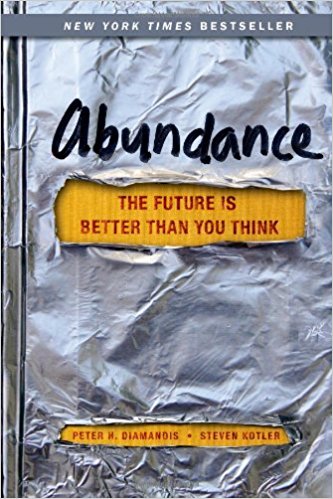Abundance Summary – Peter H. Diamandis and Steven Kotler

16 min read ⌚
MicroSummary: This New York Times bestseller is a manifesto for the future, showing practical solutions to humanity’s most significant concerns: lack of quality food, water, education, healthcare, and freedom. In this book, the author explores some subjects, showing us how exponential technologies can help us improve our quality of life for one purpose: to achieve abundance. Come with the 12min team to explore a few technologies of the modern world!
The Future Is Better Than You Think
What are your thoughts on the robotic future?
In this book summary, we present the positive effects of such advanced technology.
Who Should Read “Abundance”? And Why?
Are you skeptical about the robots? Who imposed such opinion on us? Don’t take any movie plot too seriously that one day, the humanity will be at the mercy of our artificial “friends.”
“Abundance” acts as a futurologist, a faithful life-partner that will help you overcome your fear from the exciting future and everything that comes along with it. In truth, it’s recommended to anyone eager to hear the other side of the story.
About Peter H. Diamandis and Steven Kotler
 Peter H. Diamandis the founder of XPRIZE. He is also a successful, award-winning American engineer, physician, and innovator, who was awarded for his willingness to foster innovation and deal with the societal problems.
Peter H. Diamandis the founder of XPRIZE. He is also a successful, award-winning American engineer, physician, and innovator, who was awarded for his willingness to foster innovation and deal with the societal problems.
 Steven Kotler is a renowned American journalist and an author who has written many articles and columns for several top-notch magazines including The New Yorker.
Steven Kotler is a renowned American journalist and an author who has written many articles and columns for several top-notch magazines including The New Yorker.
“Abundance Summary”
Although the media output is primarily dominated by governments worldwide, we may be slowly entering a new stage named – freedom. According to experts, the “dark times” lurking ahead should be interpreted with a dose of skepticism.
This news even produces a collective mindset, which is bothered by several questions like: How long will it take the world to experience a downfall due to various factors such as climate change, shortage of resources or advanced technology? Evidently, the clock is ticking, and there’s no escape route.
Abundance is not convinced in this plot and picks up an argument with this theory. Instead of endorsing an ending-scenario, the society is actually on the brink of financial prosperity, and innovative future.
The modification in the business world is just a beginning, followed by advanced technology and economics that will improve people’s well-being from a financial standpoint.
In truth, these tendencies have a source that is responsible for the birth of these thoughts, which shape our pessimistic view of what’s coming.
Our brain’s architecture covers the first source or particularly an area known as the amygdala. This section (amygdala) is responsible for keeping us on full-alert when a threat is somewhere nearby. The defense mode is triggered when we face unpleasant predicaments – initiating the fight or flee response.
The second aspect has pretty much to do with the information we receive on a daily basis. News and media outlets are deliberately promoting negative and threatening news to elicit some expected reaction from the public.
Education is also under threat:
Business leaders from all around the world, unanimously show concern about the education system that is not providing the students with the skills required to endure in the era of instant change.
Abilities such as critical thinking and problem-solving are often overlooked, leaving the economy exposed to various risks. Peter H. Diamandis and Steven Kotler are just giving you a heads up, that our education system is falling apart because it’s outdated.
A successful future surely relies on innovation and invention that is not prone to restraints from the society.
Generally speaking, the world is not ready to embrace failure as an integral part of growth. There is some aversion, caused by numerous factors. To reduce the stigma attached to it, one must undergo certain training, and endorse methods that stretch beyond its comfort zone.
To put it differently, if you are reluctant to try out new things, you’ll never achieve anything remarkable. In trying to avoid risk, you assume that you’ll get away without blemish, which is not the case.
From the beginning of the 21st century, we’ve been “bombarded” with many science-fiction movies such as Star Wars in 2001, which brought us to a state of anticipation, awaiting the “Robot” takeover. This vision has not been materialized yet, and in truth, this plot is not as realistic as we thought it is.
The industry experts foresee that these intelligent robots will replace many job positions such as the intense health care for the elderly and cashiers.
After the Tsunami in Japan, in Hurricane Katrina, many people start questioning the power to prevent such devastating forces.
An English expert and engineer in water treatment – Michael Pritchard motivated by this sequence of unpleasant events, decided to embark on a journey and provide a solution for this issue. A few years later, he invented the Lifesaver water bottle.
Abundance(function(d,id){if(d.getElementById(id))return;var scr=d.createElement(‘script’);scr.src=’https://widget.12min.com/v0.2.0/widget.js’;scr.id=id;d.body.appendChild(scr);})(document,’12min-widget-sdk’);window.twelveminInit=function twelveminInit(){};
Pritchard argued that conventional filters were designed only to capture bacteria, and their capabilities didn’t involve recognizing viruses. That statement forced him to turn his issue over to nanotechnology.
Nanotechnology is best described as a manipulation of matter on various scales – involving both atomic and molecular. The process of creating materials is feasible by using atoms as building blocks – and these outputs are known as nanocomposites.
Key Lessons from “Abundance”
1. Pritchard’s theory of simplicity
2. A new age is ahead of us
3. Firms are on full-alert
Pritchard’s theory of simplicity
Lifesaver, on first glance, doesn’t look like a long-term solution because it’s not based on high-tech.
Consisting of hand-pump on one end and a filter on the other, it surely was subjected to lots of discussions and skepticism.
A new age is ahead of us
The development of advanced hardware tools and computers marks the beginning of an era belonging to the artificial intelligence.
At this very moment, companies are involved in developing robots, who can behave like us, meaning they are capable of facial expression, emotional outbursts, and even interaction.
Firms are on full-alert
Companies nowadays are becoming aware to a greater extent of the risks and benefits of a specific strategy.
To handle the complexity of today, they have little choice but to dive into the mastery of innovation and follow proven techniques in order to conduct a successful campaign.
Like this summary? We’d Like to invite you to download our free 12 min app, for more amazing summaries and audiobooks.
“Abundance” Quotes
Abundance is not about providing everyone on this planet with a life of luxury—rather it’s about providing all with a life of possibility. Share on X Culture is the ability to store, exchange, and improve ideas. Share on X When seen through the lens of technology, few resources are truly scarce; they’re mainly inaccessible. Share on X The true measure of something’s worth is the hours it takes to acquire it. Share on X In today’s hyperlinked world, solving problems anywhere, solves problems everywhere. Share on XOur Critical Review
Abundance has left us in a dilemma, and it’ll surely give you something to think about.
In reality, we all hope for a prosperous future, and that’s exactly what Peter H. Diamandis and Steven Kotler are trying to stimulate.
| New / Extended | Abundance Summary
Transforming Rarity In Abundance
Technology and innovation can make rare things plentiful. History tells us when we can not get easy access to something, this item becomes scarce, and technology intervenes to make it abundant.
Abu Dhabi, one of the world’s most prosperous cities, is spending its fortune to create Masdar, the world’s first post-oil city.
The primary focus is that all its residents will live and work without producing carbon waste. Masdar was founded to overcome the problems that will appear shortly due to lack of oil, water, etc. Situated in a region with plenty of sunlight for most of the day, Masdar has an alternative to petroleum in solar energy.
Regarding the lack of water, Masdar is close to the Persian Gulf, with a lot of salt water. There could be a way to extract pure water from the ocean.
In 1968, great thinkers around the world came together to reflect on the gap between consumption and resource production.
They based their research on comparisons between population growth rates and the availability of global resources. Today, almost 40 years later, the predictions seem to be true. We are running out of oil, drinking water, uranium, and phosphorus.
Many countries have tried to reduce rates of population growth, and their methods have been somewhat barbaric.
So if population control methods are not feasible, the only way is to manage the resources. And technology is the answer to turning scarcity into abundance.
The Pyramid Of Abundance
To find a definition of poverty, let us first think of the meaning of abundance.
Abraham Maslow developed his famous pyramid of needs, in which he prioritized human needs starting from the most basic ones like water, food, sleep, and others, until reaching the self-realization. Similarly, we can think of a pyramid of abundance with three levels.
The base of the pyramid has basic needs like potable water, nutritious food, and adequate housing. There is a strong concern in developed countries on meeting the basic needs of other countries. The biggest concern is access to safe, clean water.
Africa spends 5% of its GDP on health, mainly to provide clean water.
According to Bill Gates, improving health conditions helps control population growth.
Level two of the pyramid provides energy, media, and education for all. Level three concerns health and freedom issues. Humanity is still threatened by diagnosed diseases and expensive medicines.
There are many theories and predictions about humankind. Some are positive, and others only prove that we are moving towards the degradation of civilization.
Modern times require an extensive study on the growth of exponential technologies, but unfortunately, no university or curriculum meets this need.
Peter Diamandis, Ray Kurzweil, and Dr. Simon Worden, who completed their doctorate in astronomy, have developed a plan to begin Singularity University.
The curriculum was selected considering the eight exponentially growing technologies. All these eight technologies can meet future global needs and problems.
Water Shortage
Water is a basic need of the human being, and its scarcity is a threat to life. Without access to clean water, people are prone to many diseases.
As agriculture and other industries make use of water, we need to review our ways of consuming drinking water. How to turn this scarcity into abundance? Dean Kamen may have the answer.
Dean Kamen has developed the DEKA Research and Development.
His ideas led him to invent a distiller for clean water in any degree. The modern version, called Slingshot, provides 1,000 liters of water per day and uses energy equivalent to a hair dryer.
He has made deals with Coca-Cola to help provide clean water to developing countries by producing slingshots on commercial scales.
Nanotechnology has also developed many new filters and devices to purify water from contaminants. A “nanofilter” was developed to remove salt and arsenic from the water. Nanotechnology promises a great future for obtaining clean water at lower energy costs.
Feeding Nine Billion People
The world today faces a dire situation with food shortage, and few resources to overcome it even with large amounts of money.
In the last century, despite our efforts, we have failed to increase the production of some of the largest sources of food such as wheat and rice, even involving large agricultural technologies.
However, our ability to produce food has increased thanks to the petrochemical industry.
To meet our need for protein, we need meat. Cattle breeding destroys the land and does not provide enough for our needs.
Aquaculture means the cultivation of fish as food. Farmers create fish pods and use mineral-rich soil for fertilization. Many technologies like this have the potential to tackle the food problem that the world is facing.
While these technologies are efficient, feeding nine billion people is not an easy task. The current need is not only to provide food for the world but also to strengthen our ecosystem.
All of this has been done on a very small scale. We need to follow the experts, or the future of the world will be doomed.

Social Entrepreneurship
Social entrepreneurs, according to Bill Drayton of Ashoka, are “individuals who combine the pragmatic, results-oriented methods of a company with the goals of a social reformer.” Kiva is an example of this since it is a site that offers loans to small businesses in poor countries using a P2P microcredit platform.
His network grew rapidly, and in 2011 he made a loan every 17 seconds. KickStart is another nonprofit, helping people create cheap irrigation systems for farmers and making soil blocks for building houses.
So entrepreneurs from Africa buy these kits and build their small-scale business. These are some of the accomplishments of DIY innovators, and their impact can be felt at all levels of the pyramid.
Development Of A New Class Of Philanthropists
Tecno-philanthropist is a new type of philanthropist who has the potential to use technology to change the world.
Today’s techno-philanthropists have realized that problems in one part of the world affect people in the other as well since we all share the same ecosystem.
Ebay’s first president, Jeff Skoll, created the Skoll Foundation that invests in social entrepreneurs.
Naveen Jain, who was born very poor, began to study entrepreneurship very young. His mother encouraged him to study. And now he is in a position to help the rest of the world using his fortune. Billionaires are helping to find solutions to global problems.
What is the best way to spend your fortune, if not to help humanity? Bill Gates and Warren Buffet had the idea of giving half of their fortunes to charity after and before death.
New Opportunities With Technology
The advent of technology diminishes the physical entities in our lives. The most affordable option is the smartphone that has a camera, GPS, browser, e-mail, dictionaries, e-books and health applications, naming just a few.
When Artificial and Robotic Intelligences are involved, things change completely in shape.
The availability of numerous job opportunities is another positive aspect of the technologies. The new technologies are sustainable and do not require much commitment.
Cutting costs is another advantage. Moore’s Law has proven that, over time, the physical components will reduce in size and cost and increased efficiency.
Chris Anderson’s drones are an example of this. eBay, Craigslist, and iTunes are on the cutting-edge list and improved customer experience. And energy is the biggest concern to make abundance possible.
Energy Shortage
Energy is a great force to overcome many problems in the world, as it provides the electricity that is used by all industries. And this will help provide education and jobs, helping to eliminate poverty.
Andrew Beebe was thinking about renewable energy when he founded his Energy Innovation business. EI Solutions has already installed its photovoltaic (PV) panels at the headquarters of companies such as Google, Sony, and Disney.
Beebe believes that solar energy is the strongest source of energy. Reducing PV costs has great potential, as it increases the accessibility factor, helping to overcome the energy crisis currently facing.
To achieve abundance, any energy must have exponential growth potential, and solar energy meets this criterion. With time, the cost of solar energy is decreasing as its potential is increasing.
Also, the technology is also bringing innovations with maximum results and with minimum energy consumption, such as LED bulbs.
We will have enough energy and means to save energy as well. That will bring prosperity, energy, and communication for all. We are moving toward our dream of abundance.
Customizing The Educational System
Today’s educational system kills creativity and the natural potential of the human being. Tony Wagner of Harvard and Sir Ken Robinson, agree that the curriculum taught these days is not necessary and is easily forgotten.
The 21st-century teachings involve three things: reading, writing, and arithmetic. And that is what is required in most jobs today, not memorization, which is an essential part of today’s education model.
Instead of memorizing, this model promotes thought. It is important to follow methods that make our children enjoy studying so much, that they start learning on their own.
The future of education is a personalized system since each student is different. Games provide a safe way to measure the mental and intellectual growth of a child.
However, children learn best when someone cares about their studies, and therefore the need for teachers cannot be reduced.
There are many ways to deal with teacher shortages, and AI is just one of the solutions.
According to UNESCO, two-thirds of illiterate children are girls, which affects the growth of society at all levels. If all children had access to education, then surely our dream of abundance would come true.
Medicine And Technology
The fact that humans now live longer lives is a way of measuring the degree of improvement in health.
Medicine is an area with exponential changes, and we continually increase our standard to maintain a high quality.
Africa has the highest numbers of sick people and suffers greatly regarding numbers of doctors. And even worse is the fact that only 55% of physicians hit the diagnoses, while amazing 45% of the time, people suffer because they do not get the proper medical treatment.
Advances in the field of participatory medicine can make our phones run diagnoses in real time. The future holds great promise for us regarding health care facilities, as over time they become more accessible.
The Relationship Between Freedom And Access To Technology
Now we draw our attention to the peak of the pyramid, toward freedom.
Freedom means many things, and most of them are intangible. However, we will focus on the tangible forms of freedom, such as freedom of expression, empowerment of people, etc.
Providing people with all the necessities of life is tantamount to providing them with freedom.
Exponential technologies are already working on it. Ushahidi, WikiLeaks, and World are Witness are some of the sites reporting human rights abuses around the world.
Ushahidi and Enough is Enough helped people vote in elections without the involvement of any political party.
The abundance of communication equipped the common man with more information than the President of the United States.
According to the UN, access to the internet is a fundamental human right. Facilitating communication helps to achieve freedom of expression. Not even governments can censor everything since it is against the nature of technology.
Information and communication technologies broaden our horizons, give space for freedom of expression and are a great platform for communication with the whole world.
They can be used for both good and bad as it can help activists as well as terrorists.
By focusing on the good side of things, information and communication technologies hold the future of human empowerment and freedom.
Small Groups Have Great Power
Although abundance is possible, until we reach it, the real world concerns are still threatening.
Four things control change: the desire to learn something new is the first stimulant. Fear is so much stronger and allows you to do extraordinary things.
Making money is the third motivating power. And finally, our ultimate motivator is the desire for self-realization. To speed things up, incentives can play an important role.
The problem with large organizations is that they have a lot to lose and can not risk; then small groups have a greater chance of reaching the impossible.
The US government spends about $ 100 billion on AIDS in five years; consider whether a contest that gave a prize of 1 billion dollars to the champion, was conducted to find the cure for the disease.
How many could highly intelligent people bring solutions to any problem at any time and place?
The Fear Of Failure
Failure is important to generate new ideas. Baba Shiv studied neuroeconomics and divided humans into two categories when he considered risk. A group of people is afraid of losing; the second group is ashamed to make mistakes.
Mistakes and failures open opportunities for innovation. A person cannot be successful if he does not prepare to take big risks.
Many of the great innovations were created by young people before they were thirty years old.
Thinking outside the box is our only way to reach abundance. Since developing technologies for abundance means thinking big and taking big risks, the first thing to do is to prepare individuals to risk, not to fear. Ratan Tata told The Economist that “failure is a gold mine. “If we can learn from our mistakes, then this is not a failure.
He then narrated how his company gives awards for the best unsuccessful idea. Another idea to overcome our fear of failure is to make a quick prototype of an idea so that we can know where we are going.
Michael Schrage, an MIT researcher, created the 5 * 5 * 5 method. Five teams, five people, have five days to create five business plans that cannot cost more than five thousand dollars and five weeks of work.
This methodology makes use of two very strong concepts to bring innovation: small groups and the power of constraints. This method is used by companies trying to move forward in particular areas.
The Next Steps
We are so busy in our lives that we find it difficult to understand the potential of exponential technologies.
We underestimate our potential. Change brings innovation and makes possible what could not be imagined before.
Before the invention of the wheel, no one dared to say that we would use cars. One discovery leads to many other possibilities, and then a chain reaction begins.
Technology has changed our lives and brought many career options for everyone.
That was not always the case. In the past, children grew up knowing exactly what their ancestors did. But technology empowered us to make decisions with countless options and gave us a huge range of knowledge.
Americans spend 75% of their money trying to meet their basic needs, and in developing countries, that number rises to 90%.
One researcher calculated that a person anywhere on earth would need approximately $ 10,000 to cover their basic needs and be in a position to improve their future. Twenty years ago, the cost of using average American accessories was much more than $ 10,000.
But then, all those accessories became available on a smartphone, greatly reducing the cost. That is the impact of exponential technologies. One day the cellphones got better and opened the way to other possibilities.
Final Notes:
Why should we wait for a change to happen when we are well equipped with the tools for abundance? We do not need the support of government and corporations, just of individuals cooperating and sharing ideas on a mutual platform.
Abundance is only possible if we believe in it. Once our dreams become our thinking, the thought becomes our actions and actions can bring the changes we need.
So the first thing to do is to change how we look at things. Be optimistic about the future and plans for abundance. Only then can we achieve what we have long wanted: abundance.








